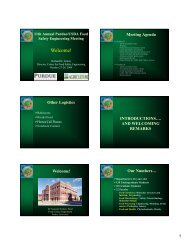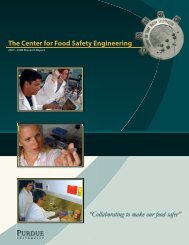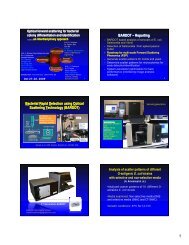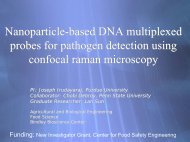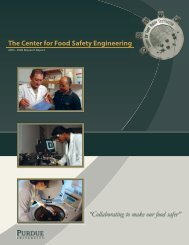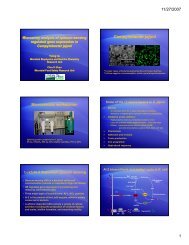2012 Newsletter - Center for Food Safety Engineering - Purdue ...
2012 Newsletter - Center for Food Safety Engineering - Purdue ...
2012 Newsletter - Center for Food Safety Engineering - Purdue ...
Create successful ePaper yourself
Turn your PDF publications into a flip-book with our unique Google optimized e-Paper software.
<strong>2012</strong> <strong>Newsletter</strong><strong>Center</strong> <strong>for</strong> foodsafety engineeringImagine a world where we can detect pathogenic bacteria in a food system within hours rather than days ......The <strong>Center</strong> <strong>for</strong> <strong>Food</strong> <strong>Safety</strong> <strong>Engineering</strong> at <strong>Purdue</strong> University is developing technologies to do just that.
eSeArch Project hiGhLiGhtSdr. rashid bashirProject titleBiochip: Microfabrication of biochips that are able toconcentrate, quantify, and detect pathogenic bacteriafrom food using PCRdr. MiChael ladisChProject titleC 3 D: Concentration of pathogenic bacteria from foodsamplesProject DescriPtioNSample preparation methods that quickly concentratethe microorganisms present in a large food sample withminimal impact on their viability are an importantfirst step in pathogen detection. The complexity offood samples makes this a particular challenge. In thistechnique, the combined use of mechanical shearingand enzyme treatments enables rapid microfiltrationof the bacteria through special membranes. The smallvolume of concentrated sample produced representsall of the bacteria present in the large food sample.This is important when the final detection method isonly capable of analyzing small volumes, such as <strong>for</strong>the polymerase chain reaction (PCR) technique.Project DescriPtioNBiochips are miniature laboratories, the size ofa postage stamp, that are able to per<strong>for</strong>m manysimultaneous functions to rapidly screen manysamples. Polymerase chain reaction (PCR) is a commonlaboratory technique used where a single piece ora few copies of a piece of DNA are used to generatethousands to millions of copies of a particular DNAsequence from a target bacterium. Coupling PCRwith biochip technology results in a rapid detectionmethod <strong>for</strong> identifying pathogenic bacteria in a foodsample.Project HigHligHtThe concentration of pathogenic bacteria fromfood samples will allow <strong>for</strong> the rapid detection ofthe bacterial pathogens near the source so thatinterventions may be implemented sooner to reducethe distribution of unsafe food to consumers.Project HigHligHtThis PCR on a biochip system is a fast, portable,inexpensive method <strong>for</strong> on-site testing of foodbornepathogen contamination.We could think of C 3 D as aquick way to find a few needlesin a haystack, and then be ableto test the needles to find outwhat kind they are.4
ScieNtific PuBLicAtioNS ANd PreSeNtAtioNS1. Bae, E., Patsekin, V., Rajwa, B., Bhunia, A.K.,Holdman, C., Davisson, V.J., Hirleman, E.D.,Robinson, J.P. <strong>2012</strong>. Development of a microbialhigh-throughput screening instrument based onelastic light scatter patterns. Review of ScientificInstruments, 83: 044304.2. Bhunia, A.K., Bae, E., Rajwa, B., Robinson, J.P.,Hirleman, E.D. 2011. Utilization of optical<strong>for</strong>ward scatter image biological database: foodbornepathogen colony differentiation anddetection. In: Omics Technologies and MicrobialModeling in <strong>Food</strong>-borne Pathogens Study.Editors: Yan, X., Juneja, V., Huang, L. DEStechPublications, Inc. Lancaster, PA. p. 599-624.3. Davis, R., Deering, A., Burgula, Y., Mauer, L.J.,Reuhs, B.L. <strong>2012</strong>. Differentiation of live, dead,and treated cells of E. coli O157:H7 using FT-IRspectroscopy. Journal of Applied Microbiology,112(4):743-751.4. Davis, R. and L.J. Mauer. 2011. Subtyping ofListeria monocytogenes at the haplotype level byFourier trans<strong>for</strong>m infrared (FT-IR) spectroscopyand multivariate statistical analysis. InternationalJournal of <strong>Food</strong> Microbiology, 150(2-3):140-149.5. Davis, R., Paoli, G., Mauer, L.J. <strong>2012</strong>.Evaluation of Fourier trans<strong>for</strong>m infrared (FT-IR) spectroscopy and chemometrics as a rapidapproach <strong>for</strong> subtyping E. coli O157:H7 isolates.<strong>Food</strong> Microbiology, 31:181-190.6. Deering, A.J., Mauer, L.J., Pruitt, R.E. <strong>2012</strong>.Internalization of E. coli O157:H7 andSalmonella spp. in plants: A review. <strong>Food</strong> ResearchInternational, 45:567-575.7. Deering, A.J., Pruitt, R.E., Mauer, L.J., Reuhs,B.L. 2011. Identification of the cellular locationof internalized Escherichia coli O157:H7 in mungbean, Vigna radiata, by immunocytochemicaltechniques. Journal of <strong>Food</strong> Protection, 4(8):1224-1230.8. Deering, A.J., Pruitt, R.E., Mauer, L.J., Reuhs,B.L. <strong>2012</strong>. Examination of the internalizationof Salmonella serovar Typhimurium in peanut,Arachis hypogaea, using immunocytochemicaltechniques. <strong>Food</strong> Research International,45:1037-1043.9. Gehring, A.G., Albin, D.M., Bhunia, A.K., Kim,H., Reed, S.A., Tu, S.I. <strong>2012</strong>. Mixed cultureenrichment of Escherichia coli O157:H7, Listeriamonocytogenes, Salmonella enterica, and Yersiniaenterocolitica. <strong>Food</strong> Control, 26: 269-273.10. Goodridge, L.D., Fratamico, P., Christensen, L.S.,Hoorfar, J., Griffiths, M., Carter, M., Bhunia, A.K.,O’Kennedy, R. 2011. Strengths and shortcomingsof advanced detection technologies. In: RapidDetection, Characterization and Enumeration of<strong>Food</strong>borne Pathogens. Editor, J. Hoorfar. ASMPress, Washington DC. p. 15-45.11. Hoorfar, J., Christensen, B.B., Pagotto, F., Rudi,K., Bhunia, A.K., Griffith, M. 2011. Futuretrends in rapid methods. In: Rapid Detection,Characterization and Enumeration of <strong>Food</strong>bornePathogens. Editor, J. Hoorfar. ASM Press,Washington DC. p. 413-420.12. Huff, K., Aroonnual, A., Fleishman-Littlejohn,A.E., Rajwa, B., Bae, E., Banada, P.P., Patsekin,V., Hirleman, E.D., Robinson, J.P., Richards,G.P., Bhunia, A.K. <strong>2012</strong>. Light-scatteringsensor <strong>for</strong> real-time identification of Vibrioparahaemolyticus, V. vulnificus, and V. choleraecolonies on solid agar plate. MicrobialBiotechnology, Published online 21 May, DOI:10.1111/j.1751-7915.<strong>2012</strong>.00349.x13. Jagadeesan, B., Fleishman-Littlejohn, A.E.,Amalaradjou, M.A.R., Singh, A.K., Mishra, K.,La, D., Kihara, D., Bhunia, A.K. 2011. N-terminalGly224–Gly411 domain in Listeria adhesionprotein interacts with host receptor Hsp60. PLoSOne, 6: e20694.14. Jaradat, Z.W., Rashdan, A.M., Ababneh,Q.O., Jaradat, S.A., Bhunia, A.K. 2011.Characterization of surface proteins ofCronobacter muytjensii using monoclonalantibodies and MALDI-TOF Mass spectrometry.BMC Microbiology, 11:148.6



